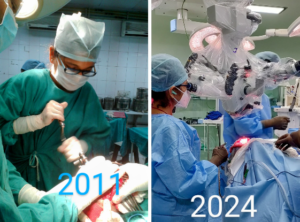Back pain is a prevalent global health issue affecting millions of people, affecting daily activities, productivity, and quality of life. It is a leading cause of disability and a major reason for doctor visits and missed workdays. Factors causing back pain include muscle strain, herniated discs, spinal stenosis, and degenerative disc disease. It can range from mild to severe discomfort, and while most cases are temporary and improve with basic care, some types may indicate more serious underlying conditions. Understanding the causes, effects, and treatment options is crucial for prevention and recovery.
Types of back pains
- Acute back pain, which lasts less than 6 weeks, often results from a sudden injury, muscle strain, or improper lifting techniques. Symptoms include sharp or severe pain, limiting movement temporarily. Treatment for this typically includes rest, pain relievers, and physical therapy. Subacute back pain, which lingers for 6-12 weeks, often stems from prolonged strain or unaddressed acute pain. Chronic back pain, lasting 12 weeks or longer, is caused by degenerative conditions, disc problems, or structural issues. Depending on the condition, treatment could involve medication, therapy, or even surgery.
- Lower back pain, caused by muscle strain, herniated disc, sciatica, or degenerative disc disease, is the most common type, causing local pain or radiating down the legs. Middle back pain is less common and causes pain in the upper and middle spine, sometimes related to rib or lung issues. Upper back pain involving the neck and shoulders can cause neck stiffness, headaches, or radiating pain in the arms.

- Mechanical back pain caused by muscle strains, ligament sprains, poor posture, or repetitive movements can be treated with physical therapy, lifestyle changes, and pain relief. Nerve-related back pain, caused by compression or irritation of spinal nerves, can cause shooting pain, tingling, numbness, or weakness in the legs or arms. Referred back pain, caused by pain from another part of the body, can cause pain from the kidneys, gallbladder, or pancreas. Inflammatory or infectious back pain, caused by autoimmune disorders or infections, can cause constant pain, morning stiffness, fever, and fatigue.
Causes of back pain
Spinal discs can cause various issues, including herniated discs, degenerative disc disease, spinal stenosis, spondylolisthesis, sciatica, spinal fractures, spinal infections or tumours, and scoliosis or other spinal deformities. Herniated discs bulge out and press on nerves, while degenerative disc disease is age-related wear and tear on discs, leading to chronic pain or instability. Spinal stenosis is characterized by the constriction of the vertebral canal, resulting in compression of the spinal cord and associated nerve roots. Spinal fractures, infections, or tumours can cause severe pain and spinal instability. Persistent back pain may signal serious conditions such as spinal infections or tumours.

Symptoms of back pain
Chronic back pain, characterized by radiating pain to the arms or legs, numbness, tingling, or burning sensations, muscle weakness, difficulty walking or balance, loss of bladder or bowel control, and visible deformities of the spine or posture, is a common symptom of sciatica.
Reasons to undergo spine surgery
Surgery may be recommended if conservative treatments, such as medications, physical therapy, or injections, do not relieve symptoms after several weeks or months. Severe nerve compression, progressive neurological symptoms, structural problems or spinal instability, spinal fractures or trauma, tumours or infections, and Cauda Equina Syndrome are all conditions that may require surgery. If these conditions persist, surgery may be necessary to relieve pressure and prevent permanent nerve damage. Progressive neurological symptoms, such as worsening numbness, weakness, or loss of motor control, may also necessitate surgery. In cases of spinal tumours or abscesses, surgical removal or stabilization may be necessary.
If you’re experiencing persistent or worsening back pain, it’s crucial to consult a spine surgeon for the best treatment. Spine surgery may be necessary to alleviate symptoms and improve the quality of life for those with severe or persistent spinal conditions. A thorough evaluation by a spine surgeon is essential. Recognizing warning signs of serious spinal conditions is crucial for timely treatment. Spine surgeons are highly trained to assess, diagnose, and treat various spinal disorders using both surgical and non-surgical approaches. Early intervention can lead to better outcomes and a faster return to a pain-free life.
About Dr Vishakha :
Dr Vishakha Basavraj Karpe is a highly skilled senior consultant at Rainbow Children’s Hospital in Banjara Hills and Hydernagar Hyderabad. She is known for her comprehensive care approach and is one of the few dedicated leading paediatric neurosurgeons in the city and India with over ten years of extensive experience in pediatric neurosurgery. Her expertise includes treating hydrocephalus, spinal dysraphism, craniosynostosis, paediatric brain infections, brain and spine tumours and stroke surgery. She has a special interest in craniosynostosis surgery, which is done only in very few centres in India.
Proficiency of Dr Vishakha:
-
- Hydrocephalus (increased fluid in the brain): The procedure involves an endoscopic third ventriculostomy and CSF diversion (VP shunt) to treat complex hydrocephalus.
- Craniosynostosis (abnormal head shape due to untimely cranial sutures fusion) surgeries: Helmet therapy is a technique that is used in both endoscopic and open surgery.
- Spinal dysraphisms(Spina Bifida)- (spinal abnormalities present by birth) – surgical repair
- Encepahaocles repair surgery.
-
- Vascular conditions and stroke surgeries: revascularization surgeries for moya moya disease.
- Pediatric brain and spine tumour surgeries.
-
- Pediatric brain and spine infection surgeries: Endoscopic and open surgeries for brain and spine infections.
- Pediatric traumatic brain and spinal injury.
- Antenatal counselling for congenital fatal neurosurgical conditions.





